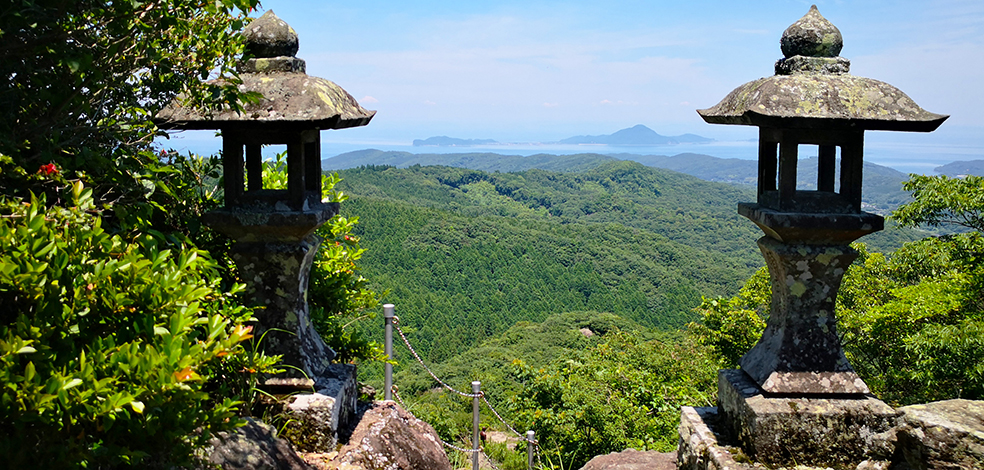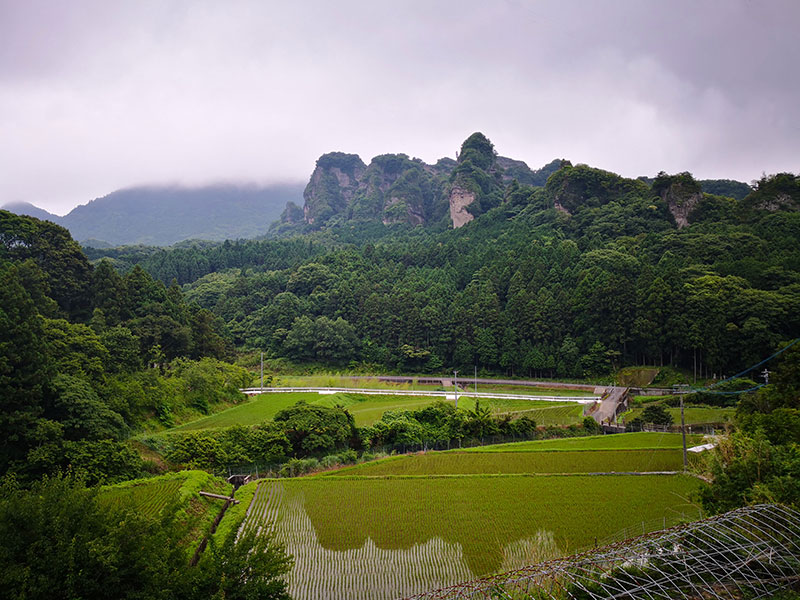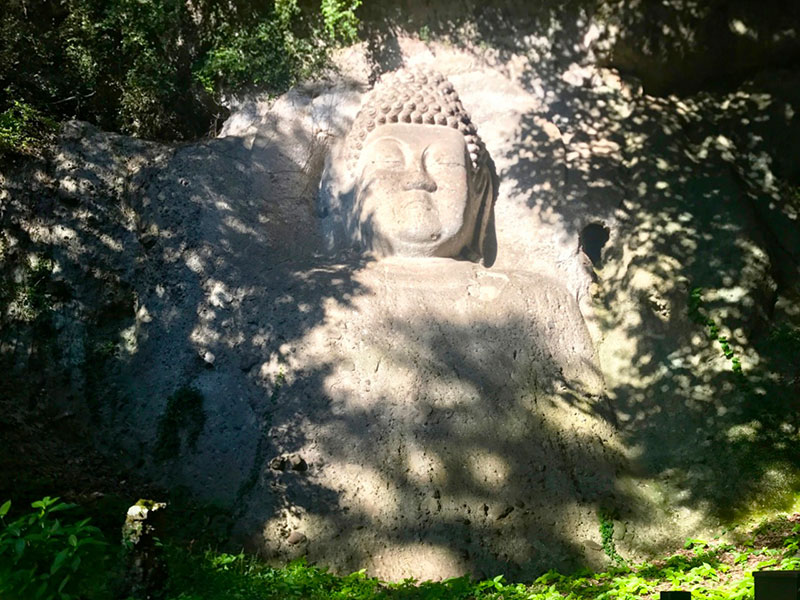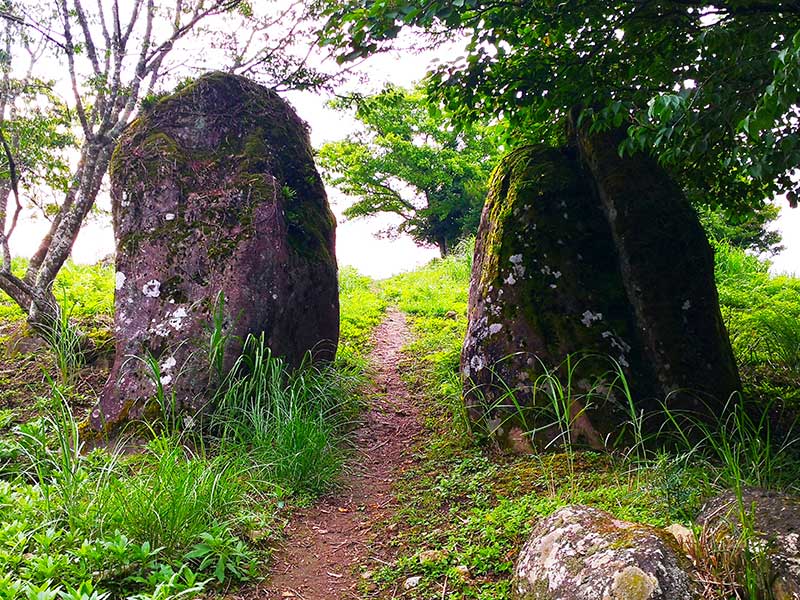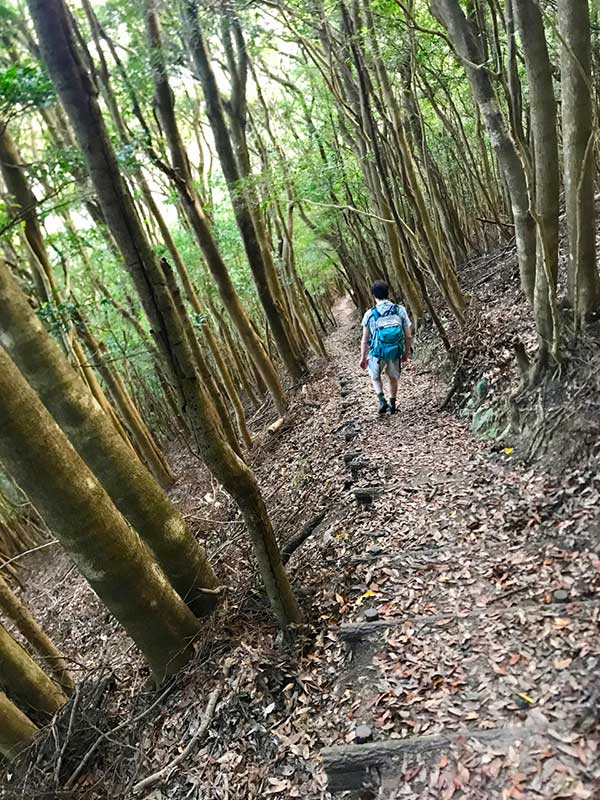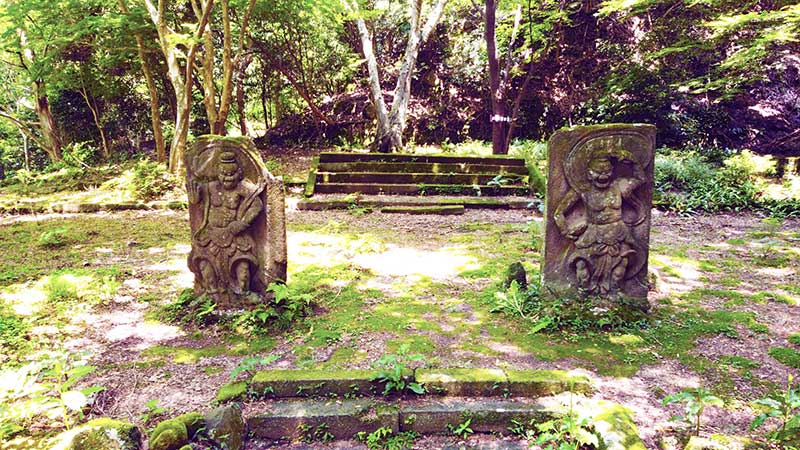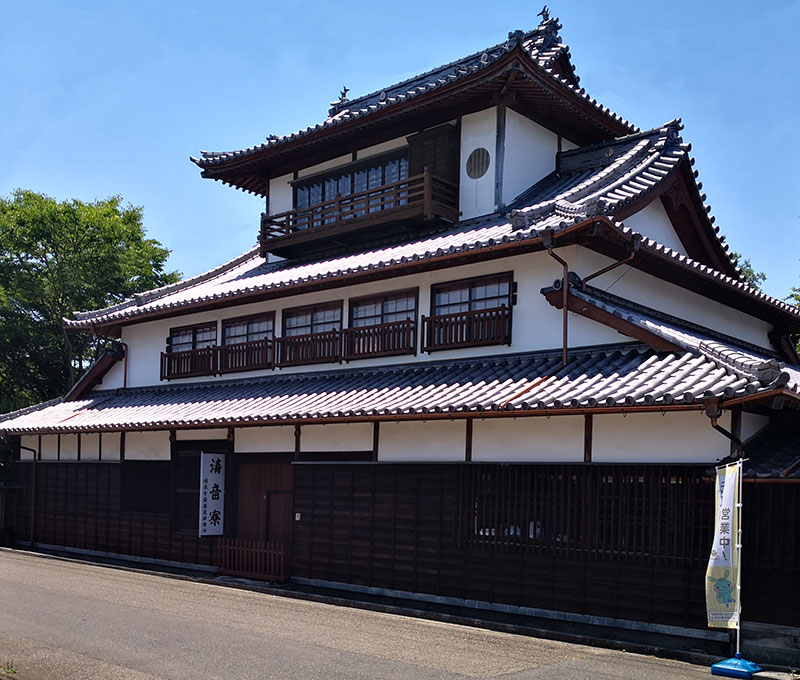A self-guided walking tour following ancient paths once trodden by monks on a beautiful peninsula in Kyushu.
Rugged forest trails and quiet country lanes lead from temple to temple through verdant and remote countryside. Stay in Japanese accommodation with onsen thermal hot spring baths and enjoy delicious local cuisine.
January - June & September - December.
The Kunisaki Wayfarer is a 6-day, 5-night tour starting in Bungo-Takada (Fuki) and finishing on Himeshima. Tour accommodation is in Japanese inns. Please read more on accommodation here. For more information please contact us.
The Kunisaki Wayfarer Self-Guided Tour takes you deep into the little-known and less-visited Kunisaki Peninsula, a picturesque and verdant haven of rural life, on Kyushu, the westernmost of Japan’s four main islands. A beautiful rustic idyll far from the hustle and bustle of Japan’s cities, here farming and fishing are still the source of livelihood for many locals. Given its charms, surprisingly most Japanese are unaware of Kunisaki let alone its history as one of the greatest centres of Buddhism in Japan.
For well over one thousand years, monks and pilgrims have walked the rocky ridges and valleys of Kunisaki. Today, they are sparse in number and the powerful, religious institutions they founded and which once dominated the peninsula have long since faded away. However, their spiritual legacy is still to be found in the charming peaceful temples and wayside shrines, which today seem to have been part of this bucolic landscape since time immemorial; and, also in the innumerable stone carvings of deities, seemingly found wherever one visits, that have cast their benign, protective gazes for centuries across Kunisaki’s tranquil mountains, valleys, fields and villages. This same legacy is also found in the Rokugo-Manzan, a 1,300 year-old, esoteric religious institution following an intriguing fusion of Shinto, Buddhist, Taoist and folk rituals that is a fundamental part of life in Kunisaki to this day.
At Kunisaki’s centre stands Futago-san, a dormant volcano and at 721m (2,366ft.) tall the highest point on the peninsula. From here, mountainous ridges interspersed with valleys fan out like rays from the sun in all directions – a delightful, physical emblem for this spiritual land. Together with the line of mountains on Kunisaki’s western edge blocking easy entry from the rest of Kyushu, the ridges further dissuaded many from delving into the peninsula’s interior. However, the remoteness created by this inaccessibility was a significant attraction for monks of old looking for seclusion, a retreat to meditate and practice their ascetics. Legend has it that in the early 8th Century Ninmon, a monk from the nearby Usa Jingu grand shrine, realised the spiritual potential of Kunisaki and set the foundations for what became over time the Rokugo-Manzan. Ninmon, who is regarded as a Buddhist reincarnation of Hachiman, the divine Shinto protector of Japan, entered Kunisaki and established its first temples. The monks that succeeded him created the grand Buddhist institutions and also established the ascetic practice of mineiri, the walking of mountain paths in prayer, meditation and recitation of sutras. While those powerful temples have long since disappeared, mineiri has proved to be a resilient, if ten-yearly intermittent, symbol of Kunisaki’s spiritual heritage now mostly embodied in Rokugo-Manzan and embraced by the few remaining monks and locals alike.
Kunisaki also boasts many small onsen hot springs, which provide a relaxing and pleasantly addictive way to bathe. Its rich local seasonal cuisine is derived from Kunisaki’s mild climate and fertile soils that together produce some of the best rice in Japan, a profuse variety of cultivated vegetables and fruit, and foraged edible plants. These in turn are complemented by plentiful fish caught in the surrounding Seto Inland Sea, locally raised wagyu beef, and occasionally wild venison and boar.
Kunisaki is truly a heavenly place on earth that holds great appeal for the adventurous traveller. Your Kunisaki Wayfarer self-guided tour starts in Usa, the home of Usa Jingu, one of the most important but least known of the grand shrines of Japan, and gateway to Kunisaki. From here on, you follow in the footsteps of monks and pilgrims over the centuries along little-trod mountain trails and quiet country lanes. Your path leads you to historic temples and picturesque sleepy hamlets, aside well-tended gardens and rice paddies, under towering cliffs and through hidden valleys, before reaching the coast and the Seto Inland Sea. The tour concludes on Himeshima, a charming island a short ferry ride from the peninsula. A head for heights and steady feet – some of the paths drop away precipitously – are required. However, the immersion in some of rural Japan’s loveliest scenery together with the warm welcome of the locals, including your hosts, farmers and priests alike, is most rewarding.
Accommodation is in traditional, family-run inns and small resorts, which nearly all feature onsen hot spring baths and meals are feasts of home-cooked, local cuisine that appeals both to the eye and the palate. Walk Japan provides tour participants with easily followed, detailed instructions on how to join and leave the tour. For further details please see the itinerary.
A Level 5 tour, the route includes a wide variety of terrain, plenty of it uneven underfoot including loose gravel, rocks and tree roots. Participants should be in good health, used to an active lifestyle and prepared to walk between five to six hours per day. There are a number of steep ascents and walking poles are strongly recommended.
The Kunisaki Wayfarer includes easy-to-follow, detailed instructions. The materials provided, including the Route Booklet, fully complement this tour and are based on Walk Japan's extensive research and its expertise derived from nearly three decades of leading guided walking tours throughout Japan, with nearly 20 years in Kunisaki. Daily walking distances are between 10–15km (6.2–9.3 miles) and elevation gain averages between 300–900m (984–2,952ft). Options may be provided to lengthen or shorten each day’s itinerary to suit your energy levels, but care needs to be taken throughout this tour, especially when it is wet underfoot. Your main luggage is transferred for you between each accommodation (in one case to a ferry terminal). Also included are transfers by private vehicle to the start and from the end of more remote walking trails.
What is included?
A pre-tour pack. The pack includes details on how to prepare for your Wayfarer Tour, how to travel from your arrival point in Japan to the accommodation at the start of your tour, weather advice, checklist and so forth. Upon receipt of a completed manifest form, your pre-tour pack will be made available for online viewing approximately two months prior to the start date of your tour. It can also be downloaded as a PDF file for offline use.
A Wayfarer Route Booklet. This is provided on arrival at your first night’s accommodation, and is an easily portable booklet. This includes detailed walking directions and logistical information, including maps, photographs and site-specific information such as lunch/cafe recommendations, museum/gallery recommendations and historical points of interest. A rain-resistant pouch and shoulder strap are also provided for ease of carrying the booklet while walking.
Click here for a sample of the Wayfarer booklet.
5-nights’ accommodation, 5 breakfasts, 2 lunches and 5 dinners.
Main baggage transfer between accommodation / port terminals.
Private vehicle transfers to the start and from the end of more remote walking trails.
In-country (Japan), 24-hour English-language emergency support.
What is not included?
Not included are flights, meals and transfers other than those noted in the itinerary.
Please note that Wayfarer self-guided tours sometimes require transfers by public buses and/or trains that are not included in the tour price. This is either because it is not possible to reserve them in advance or to allow maximum flexibility for tour participants. Please contact us for further details.

Day 1 Bungo-Takada (Fuki)
As per the information in your Pre-Tour Pack, arrive at your accommodation in Bungo-Takada. Set in a quiet rural valley, your inn, a modest idyllic place, reflects its immediate neighbour Fuki-ji, a temple that includes one of the simplest and most elegant Buddhist structures found anywhere in Japan. Dating back to the 12th Century, the temple is the oldest wooden structure in Kyushu and is a National Treasure. In cases of early arrival, a leisurely visit here is highly recommended, or you may save it for the next day. A local café or restaurant for lunch are also options for leisurely taking in surrounding rural charms.
Enjoy a relaxing dip in the inn’s onsen hot spring baths, a feature of many evenings on this tour, followed by dinner, a feast of produce mostly grown or foraged in the immediate vicinity.
Accommodation: Modern Japanese inn.
Meals: Dinner provided.
Total walking: N/A
Total elevation gain: N/A
Day 2 Fuki
Breakfast at your inn is followed by a vehicle transfer to the start of today’s walk.
This short journey takes you deep into Kunisaki’s verdant countryside to the Kumano Magaibutsu, Japan’s largest Buddha relief carvings that, in common with Usa Jingu, are little-known beyond the immediate region. A steep climb in part over uneven rocky steps, which legend has was built by an oni demon, through forest leads you to a rocky outcrop and the Kumano Magaibutsu. Here the two towering Buddhist deities, chiselled on the rock face about one thousand years ago, provide an otherworldly and apposite setting for the explorations that follow for the rest of the tour.
Retrace your steps, descend on quiet country lanes to nearby Makiodo, a temple. Although the main structure is a modern building, its outward appearance belies the treasure trove of statues found within of nine Buddhist deities. To find these wooden effigies, which are all listed as National Designated Important Cultural Properties, in such a remote area attest to the one-time importance and power of Kunisaki’s Rokugo-Manzan.
From here, your trail continues first through Makiodo’s grounds, which are dotted with stone carvings of deities and Kunisaki-to stupas. Common throughout Kunisaki but uncommon anywhere beyond the peninsula, you will frequently come across them on your travels here. Lunch, a delicious bento box, may be enjoyed here on the temple grounds.
Beyond, the trail leads through forests and aside rice paddies to Tashibu-no-sho, a charming village with some of the most picturesque countryside found in Japan. Along the way you come across Buddhist statues perched in a cave and on cliff faces. The latter overlook the tranquil scene of a hamlet surrounded by rice paddies, which has seemingly changed little for centuries.
After a picnic lunch, a winding path takes you past the carefully tended gardens of local farmhouses and around more paddies before a short climb through forests and over a low pass for the final stroll. Return to your inn to enjoy another night of relaxing onsen baths and a new array of local dishes for dinner. If time allows and you were unable to do so yesterday, a visit to neighboring Fuki-ji temple may also make for a meditative end to the day.
Accommodation: Modern Japanese inn.
Meals: Breakfast, lunch & dinner provided.
Total walking: 13.5km (8.4 miles).
Total elevation gain: 420m (1,378ft).
Day 3 Fuki – Matama
After breakfast, you leave your accommodation on foot, initially making a gentle climb up the valley along a quiet country lane before delving into forest on a steeper trail. Cresting a pass the undulating descent leads to a delightful natural spring. Popular with locals, you may replenish your water supplies and relax a little here before continuing further along on the trail to a peaceful man-made lake. A small restaurant aside its shore run by local villagers provides simple but delicious homely fayre. Enjoy lunch while soaking up the beautiful views over the placid waters, which are used to irrigate local rice paddies, to a rugged mountain ridge beyond.
Journey across the top of the dam before once again delving into forest on a trail skirting around Mt. Yayama to Choan-ji, once Kunisaki’s most powerful temple. Centuries ago a castle stood atop Yayama, a symbol of Choan-ji’s importance. Today, however, the temple’s well-tended peaceful gardens, renowned locally for flowers blooming throughout the year and the autumnal colours of its trees, reflect its genteel waning of fortune.
From here, a short but steep descent leads to the floor of a narrow valley and Tennen-ji, a thatched-roofed temple set into a cliff face aside a river within which is Kawanaka-Fudo, a large rock carved with deities. Colourful Koi carp swim languidly in the waters and the photogenic scenery is capped by Mumyo-bashi, a stone bridge lodged precariously between two cliff faces high above. Tennen-ji is one of only three temples that still hold Shujo-Onie, an impressive lunar new year festival distinctive to Kunisaki. Fire, sake, dancing and wild antics of oni demons that, unusually, bring health and fortune are the hallmarks of this ancient rite. Visit the adjacent small museum dedicated to Shujo-Onie before taking your pre-arranged transfer for the short journey to your accommodation; a small resort-like inn, which also boasts onsen hot spring baths. Another delicious multi-course meal rounds off your evening.
Accommodation: Japanese-style hotel with onsen hot spring baths.
Meals: Breakfast & dinner provided.
Total walking: 15.5 km (9.6 miles).
Total elevation gain: 500m (1,640ft).
Day 4 Matama – Akane
A more demanding walking day, starting with an ascent of nearby Mt. Inomureyama. At 458m (1502ft), the mountain is not the tallest in Kunisaki, but this is nonetheless a steep and challenging climb, particularly when wet underfoot. The views on a fine day alone are well worth the effort as is the dramatic and intriguing vestige of Kunisaki’s pre-Buddhist religious roots found at the summit in the form of a circle of giant rocks. It is unclear whether these are natural or man-made but they are regarded to this day as sacred.
The trail down the mountain makes for easier passage, but like so much of Kunisaki the terrain still feels distinctly remote. A forest shrine and a seemingly deserted hamlet are reached before another climb leads through forests to the ridge's traditional crossroad point, which has long accommodated a pilgrimage for mountain ascetics.
From here the descent to the valley floor brings you to a group of Buddhist temples and a Shinto shrine. Rest here before walking the final leg of the day along a forest road to Akane and your accommodation for the night. The onsen here also include open-air baths to relax in alfresco and enjoy the mountainous scenery before another sumptuous evening meal.
Accommodation: Traditional Japanese inn with onsen hot spring baths.
Meals: Breakfast, lunch & dinner provided.
Total walking: 15.4km (9.6 miles).
Total elevation gain: 900m (2950ft).
Day 5 Akane - Himeshima
For those who would like to challenge themselves today, a morning climb up and over Mt. Sentodake awaits. If in need of a more relaxed day, a taxi can be arranged to bring you partway to the adjoining trailhead. The forest-lined path brings you to the top of a low mountain capped by a giant rock where Itsutu-ji-Fudo, a small Buddhist sanctuary, lies in its lee. From here panoramic views stretch out across Kunisaki to Himeshima, an island in the Seto Inland Sea and your destination today, and further beyond to Honshu, Japan’s main island. The descent from here passes through the atmospheric precincts of Kyu-Sento-ji, a once powerful but now mostly ruined temple. Two impressive Nio guardian deities, myriad gravestones, stone ramparts and foundations are all that remain today.
From here either walk 6km along bucolic lanes to Imi, a small port town on Kunisaki’s north coast, or alternatively ride a local bus. Imi is a quiet pleasant settlement known locally for its art galleries and well worth a stroll around before making your way to its port, where your main luggage awaits your arrival. Board the ferry for a 20 minute journey across the placid Seto Inland Sea to Himeshima, the delightful island you spied earlier today.
Your accommodation, an elegant family-run old inn, is a short walk from the quay. The island’s main settlement is a compact and friendly place, so make some time before bathing and dinner to explore the quiet streets lined with houses and vegetable plots. Sennin-do, a Shinto shrine set in a classic fashion at the end of a small, precipitous peninsular overlooking the sea, is a local beauty spot, and well worth the 10-minute walk to reach it.
Dinner at your inn is a spectacular feast focused on seafood caught from the surrounding waters.
Accommodation: Traditional Japanese inn.
Meals: Breakfast, lunch & dinner provided.
Total walking: 11.5km (7.1 miles).
Total elevation gain: 250m (820ft).
Day 6 Himeshima
Today, you have time for a deeper exploration of Himeshima with options including a climb of Yahazu-dake, a 267m (875ft) mountain; a dip in an onsen hot spring; the hire of an electric car or bicycle to explore further afield on the island, or a gentle stroll along a pristine sandy beach with views over the sea back to Kunisaki. Return to the ferry port for the journey to Imi, from where a local bus service runs to Usa Station for onward travel by train.
Accommodation: N/A
Meals: Breakfast provided.
Total walking: 6km (3.7 miles).
Total elevation gain: 250m (820ft).
This itinerary is subject to change.
Travel by rail within Japan can be made by shinkansen bullet train to Kokura Station, for transfer to the Sonic Express to Usa Station. Travel from here to your accommodation can be arranged by taxi or a pickup by the innkeepers (subject to availability).
The airport closest to your first night accommodation in Bungo-Takada (Fuki) is Oita Airport, which is on the Kunisaki Peninsula. Please contact us for more details.
-----
FROM OITA AIRPORT (OIT)
From Oita Airport travel to Bungo-Takada (Fuki) either by taxi, or by bus. Please note that the latter has very limited departures.
-----
FROM FUKUOKA INTERNATIONAL AIRPORT (FUK)
From Fukuoka International Airport, take the City Subway line, which takes approximately 5 minutes to Hakata Station. From Hakata Station travel by the JR Sonic Express to Usa Station takes about 90 minutes.
-----
FROM NAGOYA’S CENTRAL JAPAN INTERNATIONAL AIRPORT (NGO), Meitetsu trains depart for Meitetsu Nagoya Station. Change to the neighbouring JR Nagoya Station for onward journey to Kokura, where transfer is made to the Sonic express train to Usa. The total journey is approximately 5 hours.
-----
FROM OSAKA’S KANSAI INTERNATIONAL AIRPORT (KIX), JR Haruka Express trains depart for Shin-Osaka Station. Transfer here to the shinkansen bullet train for Kokura, where transfer is made to the Sonic express train to Usa. The total journey is approximately 5 hours.
-----
FROM TOKYO’S HANEDA AIRPORT (HND), Keikyu trains depart for Shinagawa Station. Transfer here to the shinkansen bullet train for Kokura, where transfer is made to the Sonic express train to Usa. The total journey is approximately 6 hours 30 minutes.
-----
FROM TOKYO’S NARITA AIRPORT (NRT), JR Narita Express trains depart for Tokyo Station. Transfer here to the shinkansen bullet train for Kokura, where transfer is made to the Sonic express train to Usa. The total journey is approximately 8 hours.
The pre-tour pack includes detailed instructions, including a map, for travel to the accommodation at the start of the tour.

